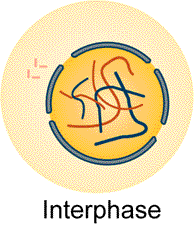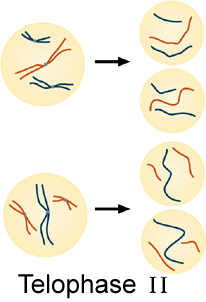
1. The correct answer is "b". False. Viruses do not have a cell membrane. They must inject their DNA into a living plant, animal, or bacteria cell where it may replicate and form many viruses. Binary fission is where the DNA replicates and each copy is separated into two cells as they pinch apart.
Press here to go back to readings. press
2. The correct answer is "b". False. Viruses may infect plant, animal,
and bacteria cells. The viruses which infect bacteria cells are calle bacteriophages.
Press here to go back to readings. press
3. The correct answer is "b". E. coli a bacterium
4. The correct answer is "b". E. coli a bacterium
Press here to go back to readings. press
5. The correct answer is "a". mitosis in human skin cells
Press here to go back to readings. press
6. The correct answer is "c". T virus This is a plant virus.
Press here to go back to readings. press
7. The two cells should resemble the following figures.
Diploid Haploid
Haploid
Your diploid cell should resemble the left figure. The chromosomes
appear as three homologous pairs (one long pair, one medium length pair
and one short pair). The haploid cell should resemble one of
the four cells on the right. Three different chromosomes (non paired).
Press here to go back to readings. press
8. The correct answer is "b and c". The chromosomes represented in
these cells are not homologous pairs.
A
B
C
2n 1n
1n
Press here to go back to readings. press
9. Meiosis only occurs in the plant and animal sex organs. In animals
the male organs are the testis and the female organs are the ovaries. In
plants the male organ is the anther and the female organ is the ovule.
Press here to go back to readings. press
10. The sperm is the male gamete and is always haploid.
Press here to go back to readings. press
11. The zygote is always formed by the union of a sperm and egg; therefore,
the zygote is diploid.
Press here to go back to readings. press
12. The term gametes refers to the sex cells - sperm and egg.
Press here to go back to readings. press
For information on how to use this page, go to How
to Use This Site.
Created by the Center for Learning Technologies, Academic Technology Services.
Last modified October 22, 1997.